

|
| ÖSTERREICH | AUSTRIA |
| Bundesland: Oberösterreich | Upper Austria |
| Stadt: Steyr |
Steyr is situated at an elevation of 310 m at the confluence of the rivers Steyr and Enns in eastern Upper Austria.
The name Steyr come from the Celtic name of the river Stiria. The Celts had come into the country around 600 BC
and started to mine for iron at the Erzberg mountain. The Romans continued the
mining activities and used the river Enns for the transport of the metal to Lauriacum (Lorch, today part of the city of Enns).
Historians believe that they had build a tower on the rock between the two rivers at Steyr. From the 6th century onward, Bavarian tribes
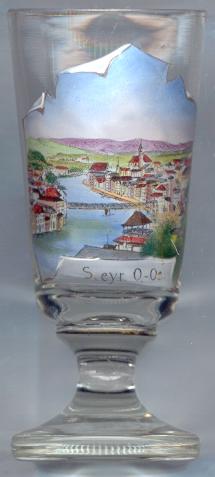 settled. Later, the area was colonised by the monastery of Kremsmünster, which was founded in 777. In order to protect he country against the
invading Hungarians, two castles were built around 900 at Enns and at Steyr. The 'Stirapurch' castle was mentioned
first in 985/990. The owners of that castle were the counts of Wels-Lambach, who also were in possession
of large areas in the Traungau and in the Carantanian march (today Upper Styria). Around 1055 the counts were succeeded by the
Otakars who obtained the status of margraves of the Carantanian march in 1056 (margarves of Styria in 1082 with Otakar II).
The last male heir of the family, Otakar IV, obtained the rank of a Duke in 1180. After his death in 1192, Steyr and the duchy of Styria
became parts of the Austrian countries following a contract between Otakar IV and the Babenberg Duke Leopold V of Austria.
Although Steyr thus lost its imoprtance as a residence it still flourished due to the trading in wood and of iron from Innerberg (Eisenerz).
Already in 1170 Steyr was mentioned as a town. During the Middle Ages, Steyr was the second-richest town in Austria after Vienna.
After 1525 most of the citizens of Steyr converted to the Protestant faith.
Trading in iron, however, slowly lost its imoprtance towards the end of the 16th century. During the counter-reformation, all
citizens who remained faithful to their denomination had to leave the country. Many of them emigrated to Solingen and
established the later famous steel-manufacturing industry there. During the Baroque period, trading in iron had lost all of its importance,
but iron and steel manufacturing again flourished. At the beginning of the 19th century the manufacturing of weapons and later of guns
settled. Later, the area was colonised by the monastery of Kremsmünster, which was founded in 777. In order to protect he country against the
invading Hungarians, two castles were built around 900 at Enns and at Steyr. The 'Stirapurch' castle was mentioned
first in 985/990. The owners of that castle were the counts of Wels-Lambach, who also were in possession
of large areas in the Traungau and in the Carantanian march (today Upper Styria). Around 1055 the counts were succeeded by the
Otakars who obtained the status of margraves of the Carantanian march in 1056 (margarves of Styria in 1082 with Otakar II).
The last male heir of the family, Otakar IV, obtained the rank of a Duke in 1180. After his death in 1192, Steyr and the duchy of Styria
became parts of the Austrian countries following a contract between Otakar IV and the Babenberg Duke Leopold V of Austria.
Although Steyr thus lost its imoprtance as a residence it still flourished due to the trading in wood and of iron from Innerberg (Eisenerz).
Already in 1170 Steyr was mentioned as a town. During the Middle Ages, Steyr was the second-richest town in Austria after Vienna.
After 1525 most of the citizens of Steyr converted to the Protestant faith.
Trading in iron, however, slowly lost its imoprtance towards the end of the 16th century. During the counter-reformation, all
citizens who remained faithful to their denomination had to leave the country. Many of them emigrated to Solingen and
established the later famous steel-manufacturing industry there. During the Baroque period, trading in iron had lost all of its importance,
but iron and steel manufacturing again flourished. At the beginning of the 19th century the manufacturing of weapons and later of guns
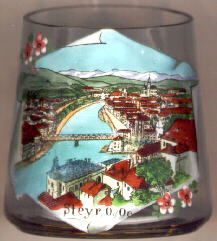 became an important economic factor for the town.
became an important economic factor for the town.
The  city parish church Sankt Ägid und Sankt Koloman [background centre right]
was built in 1443–1522 in Gothic style in place of an earlier, Romanesque church. It is one of the most importance examples of
Gothic architecture in Upper Austria. It is almost certain that it was built by master builders who had also been involved in the construction of
St. Stephen's cathedral in Vienna. In 1522 it was completed with the exception of the vaulting of the nave.
It finally was completed only between 1629 and 1636. Most of the interior decorations date from the Baroque period.
After a fire in 1876 the tower of the church (80 m high) was rebuilt in 1885–1889. The Neo-Gothic high altar was created in 1857.
At the same time the three Gothic windows of the choir, which had been waled up in 1522, were uncovered again.
The baptismal font dates from 1569. The organ was created in 1774–1779 by the famous organ-builder Franz Xaver Chrisman.
city parish church Sankt Ägid und Sankt Koloman [background centre right]
was built in 1443–1522 in Gothic style in place of an earlier, Romanesque church. It is one of the most importance examples of
Gothic architecture in Upper Austria. It is almost certain that it was built by master builders who had also been involved in the construction of
St. Stephen's cathedral in Vienna. In 1522 it was completed with the exception of the vaulting of the nave.
It finally was completed only between 1629 and 1636. Most of the interior decorations date from the Baroque period.
After a fire in 1876 the tower of the church (80 m high) was rebuilt in 1885–1889. The Neo-Gothic high altar was created in 1857.
At the same time the three Gothic windows of the choir, which had been waled up in 1522, were uncovered again.
The baptismal font dates from 1569. The organ was created in 1774–1779 by the famous organ-builder Franz Xaver Chrisman.
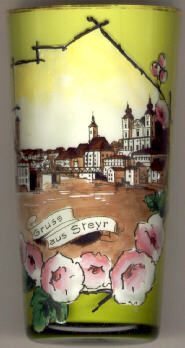
The  Michaelerkirche (church of St. Michael) [right, no. 036: far right]
was built in 1635–1677 by the Jesuits who had been called into the town in 1630. It is well-known
for its rich Rococo interior decorations. An unusual feature of the church is that it was built on a ground plan
that is oriented towards the north rather than the east. The two towers were heightened in 1766–1777.
After the dissolution of the Jesuit order in 1733 the church at first became subordinate to the city parish church.
In 1784 it became the parish church of the newly established suburb parish.
Michaelerkirche (church of St. Michael) [right, no. 036: far right]
was built in 1635–1677 by the Jesuits who had been called into the town in 1630. It is well-known
for its rich Rococo interior decorations. An unusual feature of the church is that it was built on a ground plan
that is oriented towards the north rather than the east. The two towers were heightened in 1766–1777.
After the dissolution of the Jesuit order in 1733 the church at first became subordinate to the city parish church.
In 1784 it became the parish church of the newly established suburb parish.
The  fomer Bürgerspitalkirche [right, no. 036: centre]
was built around 1500 as the church of the citizens' hospice, which had been mentioned already in 1170.
In 1785/1786 it became the parsonage for the church of St. Michael (see above).
At the same time the tower received its Baroque roof.
fomer Bürgerspitalkirche [right, no. 036: centre]
was built around 1500 as the church of the citizens' hospice, which had been mentioned already in 1170.
In 1785/1786 it became the parsonage for the church of St. Michael (see above).
At the same time the tower received its Baroque roof.
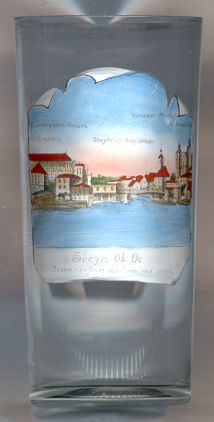
The castle  Schloss Lamberg [left, no. 1129: left]
is situated at the site of the Stirapurch castle, which was mentioned around 985/980.
Parts of the old castle keep may date back to the fort that had been built by the Romans on this site.
During the 11th century the castle was transformed into the residence by the Otakar margraves. It remained
their residence until 1122 when the Otakars were succeeded by the Babenberg dukes of Austria.
After 1278 it came in possession of the Habsburgs who eventually sold it to the counts Lamberg in 1666.
Until the 18th century the castle was fortified and enlarged several times.
Most parts of the old castle were destroyed by a fire in 1727, which also destroyed large parts of the whole town.
The castle was then rebuilt as a Baroque residential castle between 1728 and 1731. After another
fire in 1824 it receievd its final appearance.
Schloss Lamberg [left, no. 1129: left]
is situated at the site of the Stirapurch castle, which was mentioned around 985/980.
Parts of the old castle keep may date back to the fort that had been built by the Romans on this site.
During the 11th century the castle was transformed into the residence by the Otakar margraves. It remained
their residence until 1122 when the Otakars were succeeded by the Babenberg dukes of Austria.
After 1278 it came in possession of the Habsburgs who eventually sold it to the counts Lamberg in 1666.
Until the 18th century the castle was fortified and enlarged several times.
Most parts of the old castle were destroyed by a fire in 1727, which also destroyed large parts of the whole town.
The castle was then rebuilt as a Baroque residential castle between 1728 and 1731. After another
fire in 1824 it receievd its final appearance.
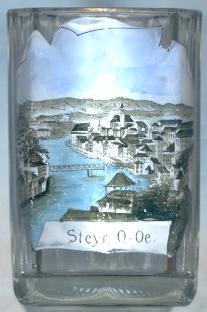
![[scale]](lineal.jpg)